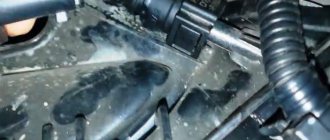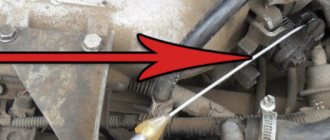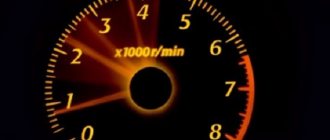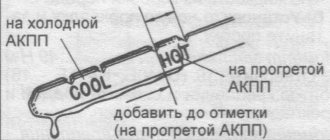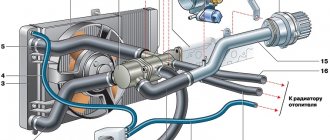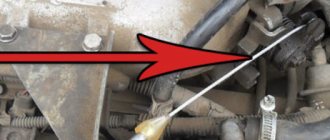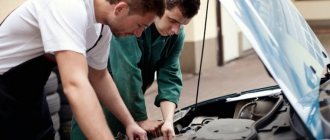Car jerks when accelerating
Back to the club VAZ / Lada (Lada) Kalina people, such a crap - when moving from 1st to 2nd speed, when I press the gas smoothly, acceleration proceeds normally, but if I press the slipper more, the car starts to twitch and only then accelerates. This recently started happening after a full tank of gas was filled with new gas, so to speak. I've been driving this tank for two weeks now. Could this be due to the gasoline? before everything was normal, viburnum 1.4
neither the spark plugs nor the coils have been changed since the previous owner, as long as they were with him - idk. Well, it's definitely not because of the gasoline?
Possibly condensation. Try to drown it as much as possible and fill it with 95-one, it removes condensate well
and gasoline could also be the culprit.
not long ago there was a dip in the gas, if you suddenly need to pick up speed, the car jerked up to 2.5 revolutions, but then everything became normal, went to the diagnostics, showed that there was a misfire in cylinder 1, the diagnostician said change the coil. The coil broke, replaced it, bought new ones, everything is fine.
To find out exactly where, do you need to do a shorter diagnosis? Well, I'll try to fill it with another gas first. If it doesn't help, you'll have to send it for diagnostics.
yes, start small. Well, look at the spark plugs, there is oil in the wells of 16kL engines
The other day I changed the coil myself, but I didn’t know that it was drizzling. 800 rubles for a coil, although in the store it’s 600 and 150 rubles for work and 500 rubles for diagnostics. Here
Yes, she doesn’t seem to eat butter. I’m telling you, this crap recently began to appear when I filled up a whole tank of 95 gasoline. I went somewhere for a week, everything was fine, and then such failures began
There was a case - here a guy from Kirov asked for help and said he refueled, drove 30 km and started getting stuck and sometimes tripping. We took out the pump, and there was an emulsion at the bottom of the tank, floating in large spots
tough((but what’s interesting is that there are failures precisely when switching to speed 2. When I switch to speed 3 from the second, everything is fine
pull the coils out of the wells and look at the rubber bands (insulators) What year is the car?
The car jerks in first gear or second speed: fault diagnosis
As mentioned above, in such a situation, the first step is to gradually eliminate problems in the power supply system, ignition, as well as failures in the ECM. For example, a common reason when the car jerks at low speeds when engaging first and/or second gear is insufficient fuel/air supply to the engine or impaired mixture formation.
Various ECM sensors (Hall sensor, TPS, mass air flow sensor, etc.) can also malfunction. If everything is fine with the sensors, then you need to check the engine ECU. Quite often, the problem of jerking in 1st-2nd gear is directly related to the ignition. It is necessary to check the condition of the spark plugs and high-voltage wires, distributor and other elements on a particular machine.
As a rule, if the car drives jerkily, in relation to injection cars, specialists conduct comprehensive computer diagnostics of the engine. If such a check does not produce results or the cause is not found, then the vehicle’s transmission deserves special attention.
So, if your car is noticeably jerky in 1st and/or 2nd gear, it is important to understand that the transmission may also be causing the car to jerk when driving. At the same time, it is easier to determine the cause in the case of a manual transmission, while various types of automatic transmissions require more serious checks
Let's start with the manual transmission.
Please note that if an inexperienced driver's car jerks in first gear when starting off, it should be borne in mind that often beginners simply make mistakes when releasing the clutch, while the car itself is working properly
To start without jerking, you need to smoothly release the clutch before the driver feels the grip point (the beginning of the transmission of torque from the engine to the wheels). After the force begins to be transmitted to the wheels and the car begins to move, you need to carefully add gas, dosing the traction with the pedal accelerator.
But jerking is usually caused by problems with the clutch on the manual transmission or its adjustments. For example, a car jerks in first and second when the clutch driven disc is badly worn, the clutch does not “close” completely, and slips. This leads to the car jerking when changing gears.
In this case, jerks most often appear precisely in “low” gears (first, second speed), when the smoothest possible operation of the clutch is needed and at the same time, through the clutch in these gears, a sufficiently large torque is transmitted from the internal combustion engine to the gearbox when accelerating the car.
Now let's move on to automatic transmissions. First of all, you need to take into account that the quality of operation and smoothness of automatic transmission shifts will depend on the type of automatic transmission.
First of all, jerking can occur when driving with robotic gearboxes that have both one and two clutches. The fact is that the clutch of such gearboxes resembles in its design and principle of operation a conventional friction clutch of a manual transmission. Often the solution to the problem is to replace the DSG or AMT clutch, after which it is imperative to adapt the clutch (training, setting the grip point).
Also, in some cases, the culprit that the car jerks when driving in 1-2 gears may be breakdowns and malfunctions in the actuators that are responsible for the operation of the clutch in automated mode.
It should also be noted that the automatic transmission itself can “slip”, and the quality of its operation greatly depends on the level/condition of the transmission oil (ATF fluid). Jerking in automatic transmissions of this type may occur due to insufficient or overfilled oil, the use of a lubricant with unsuitable properties, etc.
What can happen in a manual transmission?
Even novice drivers know that gears are changed when accelerating a car, as well as when decelerating. In both cases, this must be done correctly and in a timely manner. Experts classify several reasons through which such processes can begin during movement:
Quite often, it is enough to change the driving style of the car to eliminate the occurrence of such an unpleasant phenomenon.
Car repairs
Useful tips for car repairs
LADA KALINA: JERKING AT THE BEGINNING OF MOVEMENT
At the moment the movement begins, the limiting case of a jerk—failure—most often occurs. The most unpleasant sensations are associated precisely with the delay in the engine’s response to pressing the accelerator pedal. Sometimes the engine even stalls. A jerk occurs at the moment the throttle valve begins to open, when, based on a signal from the throttle position sensor, the ECU determines the moment of transition from idle mode to load mode and must increase the amount of fuel supplied through the injectors. If the pressure in the fuel line is insufficient (even if the injection duration is increased), there is not enough fuel for a smooth start. therefore it is necessary to check the pressure in the rail.
The main indicator of the health of the engine power system is the fuel pressure in the fuel rail.
If the fuel pressure is insufficient, the following may occur:
– unstable engine operation;
– stopping the engine at idle speed;
– reduced crankshaft rotation speed at idle;
– insufficient acceleration of the car (the engine does not develop full power);
– failures in engine operation when the vehicle is moving.
To begin with, we recommend checking the reliability of the electrical contacts in the ECM wiring harness blocks responsible for the fuel supply (fuel pump module, injectors, fuel relay and corresponding fuses).
The fuel pressure in the power system is checked using a professional pressure gauge and a hose with an original fitting for connection to the valve located on the fuel rail.
1. Turn on the ignition and listen: within a few seconds you should hear the sound of the electric fuel pump. If you can't hear it, check the electric fuel pump power supply circuit.
NoteIf you turned on the ignition three times without attempting to start the engine, the electric fuel pump will not turn on again, which is not a sign of a malfunction. It will turn on simultaneously with the starter starting the engine. 3. Unscrew the protective cap of the fitting for monitoring the fuel pressure at the end of the fuel rail
Please note that the cap has an O-ring. If the ring is torn or has lost elasticity, replace it or the entire cap
Note For clarity, the operation is shown with the decorative engine cover removed.
Helpful advice If it is not possible to use a professional pressure gauge, use a regular pressure gauge with a hose and clamp. The pressure gauge must have a measurement scale of no more than 1000 kPa (10 kgf/cm2) and a division value of no more than 20 kPa (0.2 kgf/cm2)
Pay attention to the reliable connection (rolling) of the pressure gauge and hose
4. Using a metal tire valve protective cap, unscrew the valve spool (the same as in the tire)…
Note When turning the spool valve out, a small amount of fuel may leak out, so first place a rag under the fitting.
5. ...and remove it from the fitting.
6. Connect a hose with a pressure gauge to the fitting. Secure the hose to the fitting with a clamp and check the reliability of its fastening. Start the engine and check the pressure using the pressure gauge. It should be 380–400 kPa (3.8–4.0 kgf/cm2).
The following reasons for decreased pressure are possible:
– the fuel pressure regulator is faulty;
– the fine fuel filter or fuel inlet filter is clogged;
7. Stop the engine and reduce the pressure in the power system (see “Reducing fuel pressure in the engine power system”).
8. Disconnect the pressure gauge from the pressure control fitting, screw the spool into the fitting and install the protective cap on the fitting.
THE VEHICLE MOVES JERKLY
In relation to a car, a jerk is a short-term spontaneous change in the engine crankshaft speed, regardless of the position of the gas pedal. In everyday use, as a rule, there are a series of jerks.
The extreme case of a jerk is a failure - a noticeable delay in the engine's response to pressing the accelerator pedal.
Conventionally, three types of jerks can be distinguished: - at the moment of movement; - during acceleration; - during steady movement, i.e. with the accelerator pedal in constant position.
To determine the causes of jerks when driving a car with an injection engine, special diagnostic equipment is required, so in this case we recommend contacting a car service center that specializes in repairing fuel injection systems. However, as practice shows, in most cases jerking is caused by insufficient fuel pressure in the engine fuel line (rail) or a malfunction of the throttle position sensor. With some skills, you can determine the cause of jerking yourself.
Jerking when the car starts moving
At the moment the movement begins, the limiting case of a jerk—failure—most often occurs. The most unpleasant sensations are associated precisely with the delay in the engine’s response to pressing the gas pedal. Sometimes the engine even stalls.
A jerk occurs at the moment the throttle valve begins to open, when, based on a signal from the throttle position sensor, the electronic control unit determines the moment of transition from idle mode to load mode and must increase the amount of fuel supplied through the injectors.
If the pressure in the fuel line is insufficient (even if the injection duration is increased), there is not enough fuel for a smooth start.
Jerking when accelerating a car
The cause of jerking during acceleration may be, as in the previous case, insufficient fuel pressure in the fuel line.
The electronic engine control unit, having received a signal from the throttle position sensor about the intensive opening of the damper at a large angle, strives to maximize the fuel supply, but due to the reduced fuel pressure it is not able to do this.
Jerks during steady vehicle movement
Such jerking is most often caused by a malfunction of the ignition system. Diagnosis and repair are required.
On the way, you can try to do the following yourself: - carefully inspect the engine compartment. Turn off the ignition and check the secure fastening and seating of all wires and connectors at the ignition coil and high-voltage wires.
Start the engine and listen to its operation: the crackling sound when the high voltage breaks down to ground is weak, but distinct. In complete darkness, the spark during breakdown is clearly visible;
— replace spark plugs regardless of their condition and mileage.
Pay attention to the condition of the spark plugs: if it is not up to standard, the engine or its systems may need to be repaired
Additional symptoms confirming the malfunction of this sensor: - uneven operation of the engine at idle;
- reduction in maximum engine power.
Useful tips
To make it easier to identify what is wrong with the car, there are a number of recommendations:
- weak spark or no spark at all - you need to test the spark plugs. It is also worth checking the components for integrity and the presence of oil stains. You will need to inspect the armored wire. If everything is in order, then you need to inspect the module and ignition coils to prevent a short circuit;
- damage to injectors. If there are contaminants, they must be removed. If the reason is more serious, the injectors need to be repaired or replaced;
- valve is burnt out. Fuel consumption increases, compression decreases several times, the engine no longer pulls the system. Solution: measurements of indicators and, if they do not correspond to the norm, replacement of valves;
- the catalyst melts under the influence of elevated temperatures. The motor will operate in emergency mode.
New Lada: VAZ color chart with color code | Tuning VAZ Tolyatti
If you suspect that the problems are serious, then it is better to take the car to a service station
This is important because
Sometimes the causes of a malfunction cannot be discovered on your own.
You can determine why the check engine light blinks and the engine stalls on your own. But damage should be repaired only if you have skills in this matter. Otherwise, it is better to show your “swallow” to specialists.
Quick diagnostics
So, the car is started, the speed is turned on, the clutch is slowly released, and the engine speed gradually increases. But instead of smoothly starting from a stop and starting to pick up speed, the car begins to jerk - the speed fluctuates, the speed either increases or drops sharply, despite pressing the accelerator pedal.
This can continue until either the twitching goes away on its own and the car begins to confidently gain momentum, or until the engine stalls.
The same situation can be observed when reaching medium modes, that is, the engine reaches a certain speed level, after which twitching begins.
It happens that the car starts to jerk every time you change gears.
It is not necessary that uneven running occurs only under certain conditions.
It also happens that the car jerks spontaneously, without any frequency or conditions.
That is, the car can jerk just once, in any mode, and then move normally for quite a long time.
Or the car was working normally, but suddenly began to twitch sharply, and this trouble no longer goes away.
In general, there are a lot of options, but one fact remains - the car has an uneven ride, and it is advisable to eliminate it as quickly as possible before the problem gets worse.
The first thing to do is determine under what conditions the twitching occurs. The easiest way to do this is while moving.
You should drive onto a flat section of the road where there is no traffic and start testing.
At first, just get moving, then gradually increase the speed, remembering the behavior of the car and watching the dashboard.
And this must be done until the engine reaches high speeds.
Afterwards, you will need to run the test again to make sure that the conditions for the appearance of twitching are determined correctly. And only after that you can start looking for the reason.
Let's sum it up
Always start looking for possible problems among the most easily corrected points. For example, it is better to immediately check the settings of the on-board computer and its serviceability, and only then think about other possible problems. Also look at spark plugs and high-voltage wires - they are often the culprits of unexpected problems with the car's behavior.
You also need to remember about high-quality regular car maintenance. If the transmission or engine is not properly maintained, it will be extremely difficult to identify problems in the future. Fill the gearbox with high-quality oil and carry out other routine maintenance. If you have anything to add from your own experience, be sure to share the information in the comments.
Traveling by car does not always go smoothly. What to do if the car jerks when changing gears? What caused it? Drivers themselves name two main reasons for this behavior of vehicles.
Engine lost power: common causes
- Ignition problems. An ignition timing angle that is too early will mean that the fuel-air mixture is prematurely ignited. As a result, the expanding gases counteract the upward piston rather than pushing it down. Under such conditions, engine power will drop noticeably. The same is true for retarded ignition. Late combustion of the fuel-air mixture leads to the fact that the expanded gases “catch up” with the downward piston, useful energy is wasted. It turns out that in both the first and second cases, the driver intensively presses the gas pedal, fuel is consumed, but the full return from the engine does not occur. Also worth mentioning are problems associated with the vacuum and centrifugal ignition timing regulator. The fact is that malfunctions of these solutions affect the ignition timing and its change in relation to different operating conditions of the internal combustion engine. For example, when the speed increases, the regulator shifts the ignition angle. In other words, the degree of opening of the throttle valve and the increasing speed of the crankshaft at the same speed do not allow the engine to develop full power. On injection engines, a loss of power may be observed after flashing or chip tuning of the ECU in order to save fuel.
- Cylinder-piston group and timing. As mentioned above, loss of engine power is caused by wear of the CPG, failures in timing settings, or accumulation of carbon deposits in the combustion chamber. As for the gas distribution mechanism, improper valve adjustment, coke and carbon deposits can disrupt the normal operation of the valve mechanism. More precisely, the tightness of the combustion chamber is compromised due to the loose fit (adhesion) of the valves to the seats. The fit may be compromised if the valves are too tight. Engine coking also prevents the valve from closing normally. The fact is that the carbon layer prevents normal adhesion. As a result, some gases break through loosely closed valves, causing overheating, burnout of the valve, valve seats, etc. Coke deposits can additionally smolder under the influence of high temperature, causing the effect of uncontrolled ignition of the mixture, that is, glow ignition. All this leads to malfunctions and a decrease in the power of the power unit. As for the CPG, piston ring wear is a common cause of low cylinder compression. As a result, gases break through into the engine crankcase, that is, the energy of fuel combustion is again consumed with great losses. Determining the cause is not particularly difficult. It is enough to remove the crankcase ventilation hose and evaluate the degree of smoke intensity. The presence of strong smoke that pulsates will indicate problems with the rings.
- Filling with fuel-air mixture and mixture composition. Problems with the filling and composition of the fuel charge can reduce engine power even if the engine is in good condition and the ignition is set correctly. The most common cause is a dirty throttle valve or a malfunction of the throttle opening mechanism itself. Let us add that running on a lean mixture will not allow the engine to develop full power. Leaning can be caused by air leaks that occur both at the intake and in the fuel system. Another reason is contamination of the jets on the carburetor or fuel injectors/fuel pump mesh/fuel lines of the injection internal combustion engine. The air intake also deserves special attention. The first step is to check the air filter. Then you should diagnose the fuel system. To begin with, it should be ruled out that the tank is filled with fuel with a low octane number for a particular type of engine. The next step is to check the injectors and their performance, as well as the fuel pump.
Article on the topic: Comparative characteristics of summer tires - what do you need to know when choosing?
Source
The gearbox is the main culprit for jerking when shifting
Often the culprit of this problem is the gearbox. In a machine, a problem can be associated with any mechanism, and the type of jerking depends to a large extent on the type of box itself and common weak points in the design. In a manual transmission, we are most often talking about simple mechanical damage, worn gears, and so on.
In any case, knocking and twitching in the gearbox should alert the car owner. It is necessary to contact specialists as soon as possible and diagnose the node. Often, to determine the problem, you need to dismantle the box, which is a labor-intensive and expensive process. However, you can’t do without it. The most common causes of gearbox problems are as follows:
When starting off the car the viburnum twitches
Posted by USA » April 26, 2012, 00:47
Well, if you just open it up, it definitely won’t get any worse
Added after 1 minute 42 seconds:
folk method - experienced drivers also told me at one time
Messages: 29 Registered: March 03, 2011, 00:00 From: Nizhnevartovsk Experience: 3 years Car: VAZ 2110
| Rating: 29 |
| Reputation: 0 |
Post by Sanek-86rus » April 26, 2012, 00:49
Messages: 9639 Registered: Jan 21, 2008, 00:00 Awards: 1
| Rating: 55,315 |
| Reputation: +93 |
Thanked: 1418 times Thanked: 685 times
Posted by USA » April 26, 2012, 00:52
The discs won’t do anything for sure... well, if the releaser is too early to change, it costs 200 rubles separately for EMNIP. Well, or drive - it whistles - change it... maybe it will roll around. In general, the philosophy of Rashenkar is - don’t get into the car until the knock comes out on its own
| Rating: 6,328 |
| Reputation: +12 |
Thanked: 9 times Thanked: 64 times
Post by bluebird1992 » Apr 26, 2012 00:53
USA Try to release the gas, stick the third one in and move off... if you lightly burn the rims, it won’t twitch (it will get used to it). . on the classics it helps a lot - I’ve changed the clutch more than once, I’ve always done it that way
The car jerks while driving - reasons
As a rule, such jerks occur due to a malfunction of the ignition system. However, if a problem occurs on the road, you can try to fix the problem yourself. To do this we do the following:
- Turn off the ignition, lift the hood and make sure that all high-voltage wires are securely attached to the coil and spark plugs.
- Then start the engine and listen to the engine, listen for any extraneous crackling or clicking noises. The point is to check whether there are any “breakdowns to ground”, that is, whether the spark is going somewhere else other than the spark plug. This is best checked in the dark, then you will not only hear a crash, but also see how it hits, for example, on the body or somewhere else.
If the check does not lead to anything, I recommend unscrewing the spark plugs and inspecting them; perhaps there is carbon on the spark plugs or they simply need to be replaced. If you have a set of new spark plugs, check to see if the engine's performance changes or if the jerking goes away after replacing the spark plugs. If the car jerks at speed even after replacing the spark plugs have disappeared, then the problem was in them, but if not, continue searching or try to reach the nearest service center, they will certainly help you solve your problem.
Conclusion
So, finding the reason for the Lada Kalina jerking at low speeds is quite difficult, because the problem may lie in the main systems, therefore, if the car enthusiast is not confident that he can find and fix the problem, then it is better to immediately contact a car service center.
Recently, several not very pleasant symptoms have appeared on my Kalina, a list of which I have given below:
- The car began to jerk at low speeds. This was especially pronounced when shifting, if the speed was not too low for a particular gear
- Idle speed has become a little unstable, but the spread is small: from 800 to 880 rpm
- Fuel consumption has increased slightly. If earlier the instantaneous flow rate at idle was 0.8-0.9 l/hour at a temperature of 83 °C, now it has become 0.9-1 l/hour.
Poor quality fuel
Poor fuel quality is often the cause of acceleration failures. One of the possible situations that can deteriorate the quality of fuel is the ingress of water into it. If there is water in the fuel, the engine will definitely not work normally. For information: if water gets into aviation fuel, the aircraft engine instantly fails.
Substandard fuel in this area is one of the main causes of accidents in aviation. On earth, this problem costs the car owner less blood. If a car owner has filled the tank with fuel and water, then this fuel must be drained. Otherwise, you will have to change the fuel pump and injectors. If there is no way to drain the fuel, you will have to wait until the fuel is used up.
Dips when pressing the gas pedal Lada Kalina: at idle or during acceleration
Drop in speed and failure of the gas pedal
There are few reasons for the phenomenon of “failure” when pressing the gas pedal. It often appears after unsuccessful engine chip tuning and is accompanied by an increase in fuel consumption, but there are other problems directly with injection. So, let’s look at the main reasons for the “failure” effect:
- Injectors. The fuel distribution system directly affects engine performance.
- Damage to the injector.
- The fuel supply system has failed.
- Wear of engine temperature and mixture enrichment sensors.
- Errors in the electronic engine control unit.
Identifying and eliminating ECU errors
Spark plug. This is the most common cause of accelerator pedal failure.
Condition of the candles. On the left the mixture is too rich, on the right it is too lean.
These are all the main reasons that can lead to gas pedal failure.
Once the causes are considered, we can consider how to deal with the problem. So, let’s describe step by step what needs to be done when the gas pedal has dips during acceleration:
- The first step is to check the spark plugs. The appearance of carbon deposits or spark plugs that are too clean indicate that the mixture is not adjusted correctly. It is worth adjusting the correct amount of fuel mixture.
- Ignition wires can also cause the vehicle to malfunction.
- A clogged throttle can lead to failures during acceleration.
- The condition of the air filter affects the formation of the mixture, so it is worth changing it on time.
Air filter clogged
The fuel pump (main faults), as well as the condition of the fuel filter, can affect injection. Therefore, in case of failures, it is necessary to diagnose them. To diagnose, you need to remove the fuel pump and check its operation, as well as the condition of the mesh filter.
Dirty fuel filter
Dirty fuel filter
ECU errors can also lead to accelerator failures. The last reason is clogged injectors. They need to carry out diagnostics, check functionality, and also clean and replace faulty elements.
Thus, the causes of failures during overclocking have been identified and can be eliminated.
At idle, there are fewer reasons for failures, but they will have to be eliminated, since the car simply will not start normally, or stall after starting the engine. So, let's look at the work plan step by step:
- Checking the spark plugs. If the element fails, it is necessary to replace it.
Attention! It is recommended to change all four spark plugs to ensure smooth engine operation. Before installation, you should adjust the gap using a feeler gauge, which should be 1 mm for 92 gasoline
Checking and adjusting the spark plug gap using a feeler gauge
- We change the fuel filter, it is located under the bottom of the tank, and also carry out diagnostics on the fuel pump. If malfunctions are identified, they should be eliminated.
Clogged filter in the gasoline pump
We check the functionality of the idle speed sensor and cooling temperature. Fuel quality and clogged injectors also affect idle failures. Errors in the ECU can also cause this phenomenon. The performance of the injector directly affects the performance of the engine.
All these reasons can cause dips to appear at idle (more precisely, when switching from idle to driving mode).
The main cause of failures are spark plugs, but they are not the only ones that influence the appearance of this effect. Some car enthusiasts may not be able to cope with the occurrence of such malfunctions on their own, and it is necessary to go to a car service center, where they will carry out high-quality diagnostics and also fix the problem. But it is worth considering that you will have to be generous, since neither computer diagnostics nor repairs will cost a penny.
Checking VAZ-2107
Now let's take a closer look at how to identify the cause of such a malfunction on different car models.
The first will be the carburetor VAZ-2107; there are plenty of cases when the car suddenly starts to jerk while driving.
- First you need to inspect all pipes of the system for cracks;
- Open the tank. It happens that in the summer the lid fits very tightly to the neck, blocking the access of air to the tank. When moving, the pump works and creates a vacuum in the tank, due to which the same pump is then unable to “pull” fuel. It seems like a small thing, but this also happens;
- Inspect the fuel filter located in the pipes leading to the fuel pump. These filters are transparent and easy to visually evaluate;
- You can also check the fuel pump without removing it. It is necessary to disconnect the pipeline coming from the pump from the carburetor and lower its end into some container. Then manually pump the pump into action and evaluate how it pumps fuel - it should supply it in even portions;
- While the fuel pipe is disconnected from the carburetor, unscrew the fitting on which the fuel line fits and remove the small mesh filter, clean it and reinstall it;
- Next comes the carburetor. It is advisable to remove it from the car, rinse it thoroughly, and inspect the accelerator pump membrane.
If actions with the fuel system did not help, we proceed to checking the ignition system.
We unscrew the spark plugs, check their functionality, and replace them if necessary; We check the system wiring for breakdown. This can be done this way - in the dark or in a closed garage (the main thing is that it is dark), open the hood and start the engine. If there are voltage losses on the wiring, they will be immediately noticeable by the sparks that form. Next, we replace the wiring that “breaks through” and check the wire connections; Next, we check the distributor, there should be no signs of critical wear, it should be dry under the cover. Be sure to inspect the centrifugal regulator, and also check the vacuum regulator. You should check whether there is a vacuum in the pipe leading to it. Then the Hall sensor, coil and switch will be checked for functionality. You can do this yourself if you have the necessary equipment at hand, but you need to know how to check them
But you can contact an auto electrician. It is also important not to forget to check the correctness.
This is in general and all the features of identifying the cause of uneven running on the VAZ-2107.
FakeHeader
Comments 9
That's putting it mildly)))
The clutch basket is at fault. The hottest place is at the engine + gearbox connection. There are traffic jams, you have to constantly work with the clutch, the ferodo disk rubs against the basket at the moment of stopping and starting to move, not only the contact area and the petals heat up, there is simply an uneven pressure of the ferodo disk to the flywheel, so the car jumps when you start
If this happens during an active start from a standstill, then the strut slowly dies. At least that’s what I have, it was the front right pillar that was sentenced. If it just twitches when starting off (as if you were suddenly dropping the clutch), then you need to look at it. Maybe the damper itself is weird, maybe something else. I had both cases)) According to the first one, I will change the struts in any case, according to the second one, they reset the fuel adjustment, retrained it again, and the twitching disappeared. He described this in his blog.
If this happens during an active start from a standstill, then the strut slowly dies. At least that’s what I have, it was the front right pillar that was sentenced. If it just twitches when starting off (as if you were suddenly dropping the clutch), then you need to look at it. Maybe the damper itself is weird, maybe something else. I had both cases)) According to the first one, I will change the struts in any case, according to the second one, they reset the fuel adjustment, retrained it again, and the twitching disappeared. He described this in his blog.
So I’m also leaning towards the stand. When I slip, my right wheel jumps. I noticed it in the winter when I started to slip, following the tracks of a bulldozer in the snow. The right wheel was jumping like crazy(((Now I finally decided to change the struts.
I don’t know how it is with you. but on my first Kalina it was hard to get going in the back; the car was shaking as if the engine was going to fly out. and then one day the clutch cable broke, and after I changed it, the car stopped jerking, and the clutch began to be depressed like a gas pedal)) try to lubricate the clutch cable, check it when you take it off for biting,
Conclusion
So, finding the reason for the Lada Kalina jerking at low speeds is quite difficult, because the problem may lie in the main systems, therefore, if the car enthusiast is not confident that he can find and fix the problem, then it is better to immediately contact a car service center.
Hi all! A month ago a problem arose: when starting from a stop, the car began to jerk violently, especially when standing in traffic jams for a long time. At first I thought about the clutch, but it didn’t seem to slip and the thought about the clutch disappeared in the rain; when starting off on wet asphalt with grinds, the car literally starts to jump, mainly the right wheel.
Mileage: 48000 km
Ignition and injection
During normal operation, the spark plug receives an electrical signal from the distributor or electronic injection system and sends a current pulse to the electrodes in a fraction of a second. Thus, the vapors in the combustion chamber are ignited. However, there are many reasons why a spark plug may stop sparking properly.
There are many methods for detecting and eliminating problems with spark plugs, but it is better to carry out diagnostics from specialists. A novice mechanic can do the following:
- Check the wires going to the spark plugs. Sometimes rough running of the engine is caused by damaged, worn or misconnected spark plug wires.
- Replace the suspect spark plug. Throughout its entire service life, it must retain its original appearance. If the spark plug is damaged, covered with oil or carbon deposits, you should contact a professional to further diagnose the causes of this condition.
Another factor why the spark plug does not generate a spark may be a malfunction of the ignition coil. This important component increases the vehicle voltage to 30,000 volts, which is the main condition for the formation of a spark. Coil defects cause misfires, which manifest themselves as jerking of the car.
Another common problem in the ignition system is contamination of the injector nozzles. This is not a very serious defect, but it also needs to be eliminated. It is advisable to clean the injectors on a regular basis to avoid costly replacements.
Jerks at low speeds and when starting off Lada Kalina
Many car enthusiasts have come across the concept of Lada Kalina twitching at low speeds. This malfunction can be associated with different car systems, but not every car owner is able to find this malfunction and fix it.
The video shows an example when an 8-valve engine operates “jerkily”, and what to do about it:
Causes of malfunction
General view of the engine
As in any car, in the Lada Kalina, jerking at low speeds is the first sign of a malfunction in one of the systems. Let's look at where the main problems arise:
- The fuel system and its components can cause the problem.
- The ignition system is associated with the fact that the car jerks at low speeds.
- Another reason could be the gearbox.
To more accurately determine the causes of the malfunction, it is worth considering each system and component separately.
Fuel system
The car jerks at low speeds - this may be due to the fact that the engine does not receive enough fuel mixture.
The problem may lie in the fuel system. In this case, you will have to examine several elements that are part of it.
Fuel rail and fuel injectors
Let's look at finding the problem step by step:
- The first place to look for a problem is the fuel rail and injectors. It is the poor condition of this unit that can cause the car to jerk when accelerating.
- The fuel pump, filter and lines can cause the driver to feel slight jolts at low speeds. For diagnostics, you will need to remove the fuel pump from the gas tank housing. The mesh (strainer) in the fuel pump on a Lada Kalina is clogged
- Poor fuel quality is one of the reasons for this effect.
You can diagnose these components and parts yourself or contact a car service center.
Ignition
The ignition system may cause the car to jerk at low speeds
Particular attention should be paid to the ignition switch, in which the contact connections may fail
A red glow plug removed from the engine
The second reason could be the spark plugs. Their serviceability and contamination can lead to the fact that the car will not only twitch at low speeds, but also work unstably in other ranges. To prevent this from happening, it is necessary to choose spark plugs with the required gap and recommended by the manufacturer.
Transmission
The most unpleasant consequence of the effect may be the gearbox. In this case, you will have to remove the gearbox, change the oil in it and add new oil to the level. And also carry out a complete disassembly of it for diagnostics. Thus, the reasons may be failed synchronizers of 1st and 2nd gears, wear of gears or shafts. Another problem can be bearings that are worn out.
Gearbox disassembled
Of course, you should trust the diagnosis of this unit to professionals at a car service center, but if possible, you can try to fix the malfunction on your own. Ultimately, when all else fails, they will always be happy to see you at the car service center.
So, finding the reason for the Lada Kalina jerking at low speeds is quite difficult, because the problem may lie in the main systems, therefore, if the car enthusiast is not confident that he can find and fix the problem, then it is better to immediately contact a car service center.
If we talk about the carburetor engine...
What to do if you have a carburetor engine? At the beginning of the article, we already mentioned several situations in which the car jerks while driving due to improper operation of the carburetor. But the cause may also be fine fuel filters. The easiest way in this case, of course, is to replace them, but this is not always possible in road conditions. If the problem is discovered during a trip and it is not possible to visit a car repair shop, the first thing that can help is washing the filter with gasoline in reverse, since on Japanese cars it is most often installed on a direct guide to the fuel pump. This will help you get at least to the nearest car service center or garage. Some drivers resort to piercing this filter, but such advice is not only incorrect, but even harmful. The fluff that comes off will undoubtedly end up in the carburetor, which will very quickly cause this part to fail, thus requiring replacement of this expensive part. If you don’t have a “native” filter on hand, for example, from a Toyota, you can use its analogue from another car with a carburetor engine; in this case, such components are interchangeable and sometimes differ from each other only in diameter.
Some car brands (for example, Honda) have a non-standard location of the fuel pump, therefore, it will be difficult to find the filter system the first time. But if your car jerks when you drive and you want to fix it, here are some tips. Most often, the electric fuel pump will be located next to the gas tank, and the filters will be in front of it. Don't forget that engines of this type also have a third filter element. It is located in the carburetor itself, in the place where gasoline enters. To clean or at least inspect this part, it is often necessary to disassemble the carburetor, but in some cars (for example, Nissan) access to the mesh filter is much easier. The whole work process is as follows:
- Unscrew the fastening bolt of the inlet pipe.
- Remove the pipe.
- Take out the filter mesh located directly under it and clean it.
- Place the filter in its original place and attach the pipe.
If this is not possible, you will have to perform the following series of manipulations:
- Remove the top carburetor cover and turn it over.
- Pull out the float axis.
- Remove the float and shut-off corner.
- Next, go to the needle valve and unscrew its seat (you will need a small wrench or a regular flathead screwdriver for this purpose).
- Remove the saddle, turn it over, and clean the filter mesh on its reverse side.
Sometimes complete removal of the seat is not required; after removing the locking needle, it is enough to simply blow out the resulting hole with a stream of compressed air. This simple manipulation will help clean the filter efficiently. But the first filtration system that fuel goes through in carburetor engines is a strainer on the receiving pipe in the gas tank. Its cleaning is similar to cleaning filters in diesel engines, which we already wrote about above.
Let's move on to consider problems with gasoline engines, which can also cause you to feel the car jerking. As is already clear, we will analyze its filtration systems in detail. It must be said right away that the number of filters here varies depending on the location of the fuel pump. If it is located inside the gas tank, then the filtration system will consist of a receiving mesh, a fine filter and mesh filters in front of the injectors. If the pump is brought outside, then in addition to those already listed, you can find a fourth - a mesh cone-shaped filter located in the pipeline in front of the gas tank. If you want to pull it out and clean it, first remove the hose for the inlet pipe of the fuel pump, after which you can carefully remove the cone using tweezers. But do not forget that if the above did not help, and the car jerks while driving, the injector in such cases also needs to be checked for serviceability.
Air leak in the vacuum brake booster
Newer car models are equipped with sealed vacuum brakes. If this integrity is violated, air will leak into the system. It mixes with the fuel mixture, making it leaner. As a result, the mixture does not ignite well when it enters the cylinder. The spark plug becomes wet, a spark does not form and the fuel does not ignite.
This can provoke a slight adjustment of the engine, which will be noticeable in cold and hot conditions, even at idle speed. To make sure that the cause of the malfunction is air leaks, it is necessary to determine where exactly the depressurization occurred in the system.
Accelerator defects
If the driver sharply presses the gas pedal to accelerate the angular velocity of the engine crankshaft, a problematic condition may arise in the vacuum ignition angle regulators. Then, at low speeds, the distributor-chopper will sink, which will begin to affect the car by jerking when driving.
When the fuel burns slowly, the driver has no choice but to start increasing the rotation so that the engine starts faster and ignites the fuel-air mixture through the spark plugs. But vacuum regulators, working problematically, do not allow the car to quickly gain speed, and the throttle valve does not open too late. If the opening of the damper and the air supply are not synchronized, the fuel will burn for a long time, which can lead to damage to the ignition timing bearings. The problem must be solved by diagnosing the vacuum regulators.
Vacuum regulator
Vacuum ignition timing regulator
Do-it-yourself diagnostics are possible. Remove the pipe and cover it tightly with your fingers. With the engine running, you will begin to feel the suction generated by the regulators. When a vacuum forms with the air supply, the damper is definitely leaking. Then it should be replaced and everything should be assembled in the reverse order.
The reason for the car jerking when switching to low speeds can be caused by the electronic gas pedal, which is installed on cars today. It is designed and operates like an electric potentiometer. Also in contact with the protrusions, sliding along them, is a sensor that rigidly interacts with the gas control.
Although the gas pedal is sealed, it is possible that water and snow can get into it, which activates the oxidation of the metal tracks and the sensor then begins to leak worse. The throttle control function is disrupted and the car will start to jerk when the gas is applied. Disadvantages will accompany idle, acceleration and cruising speed.
